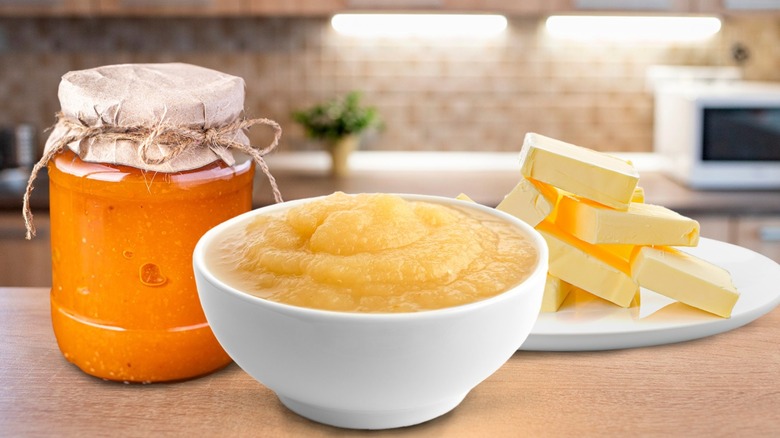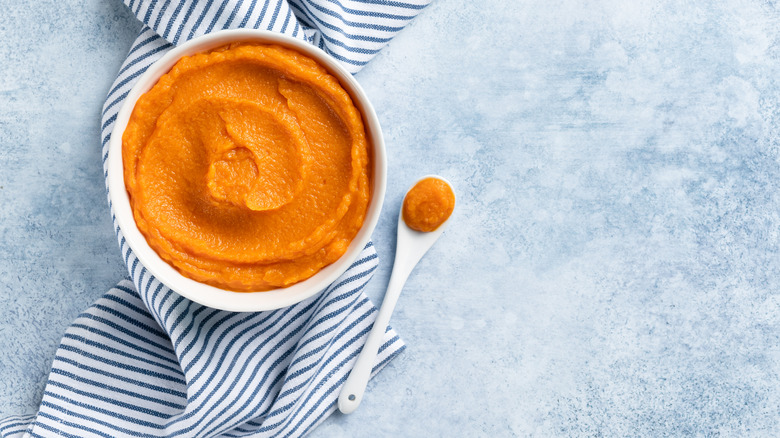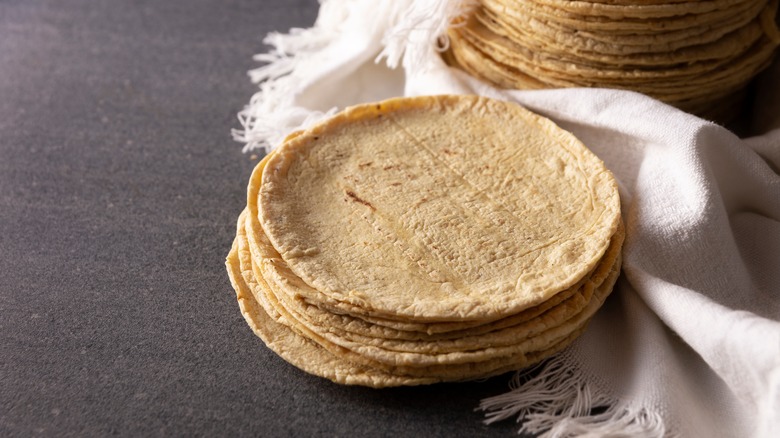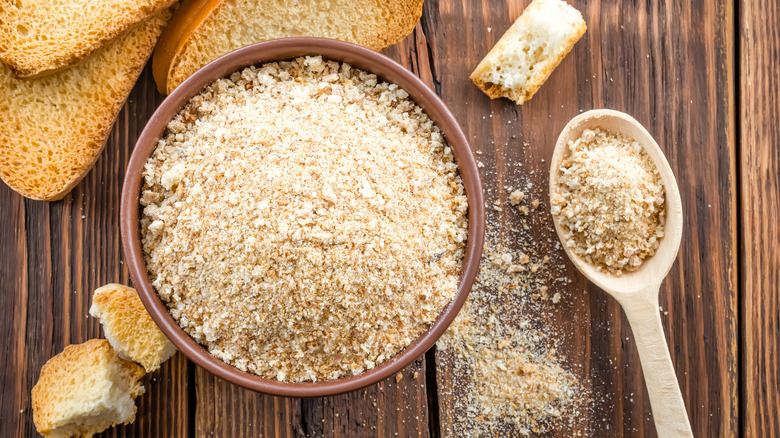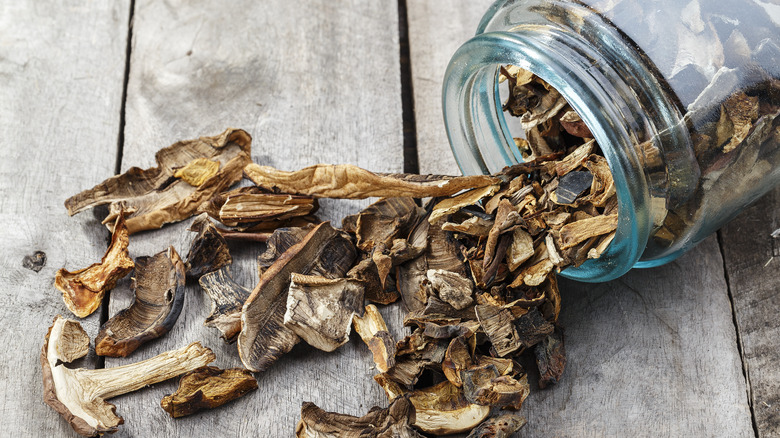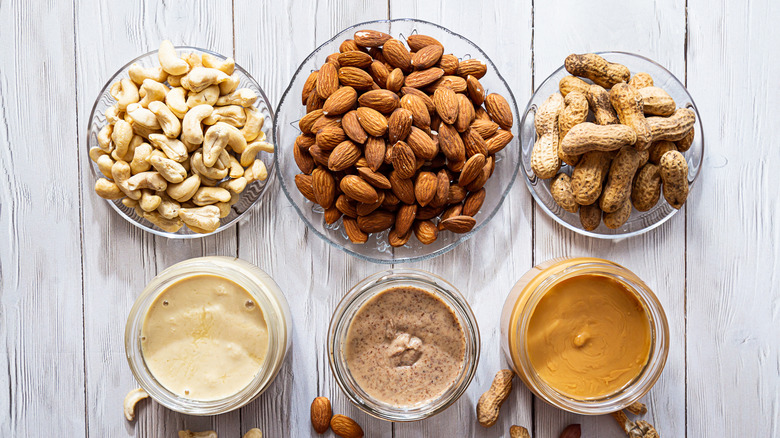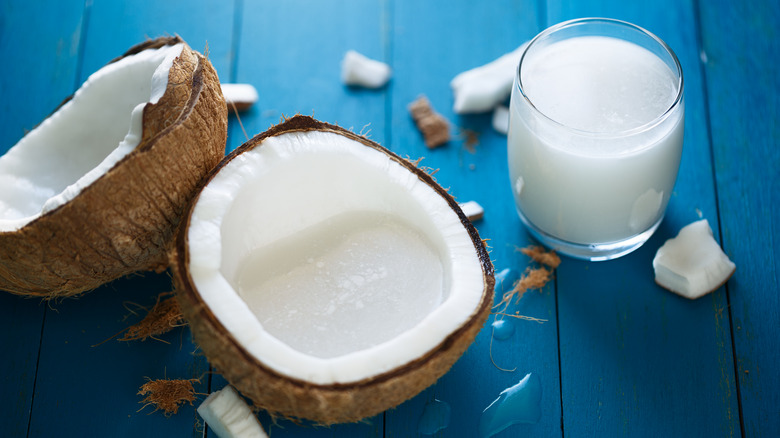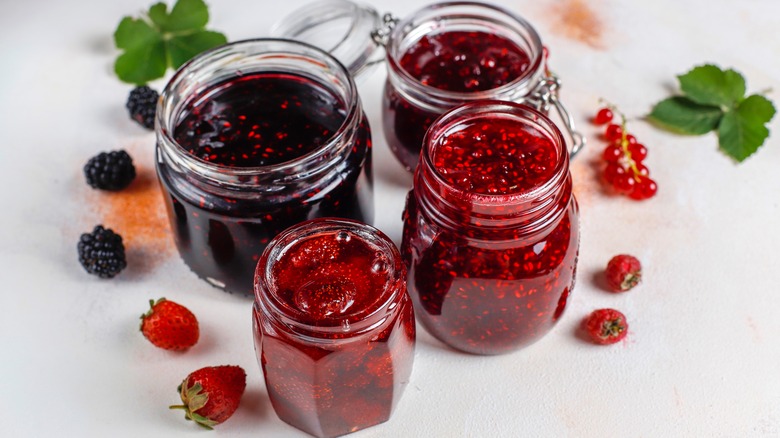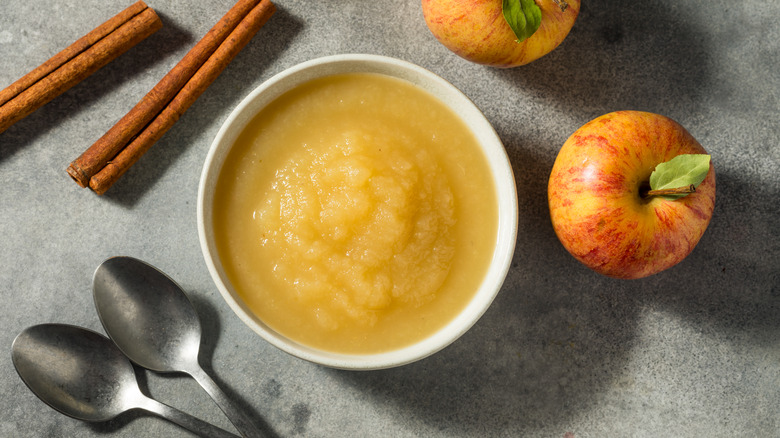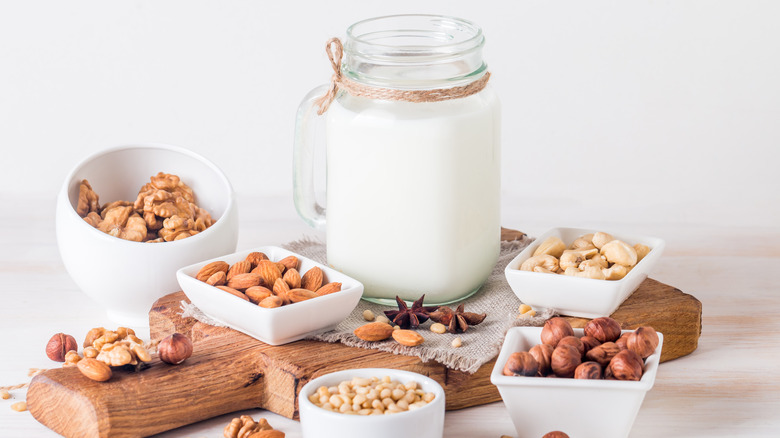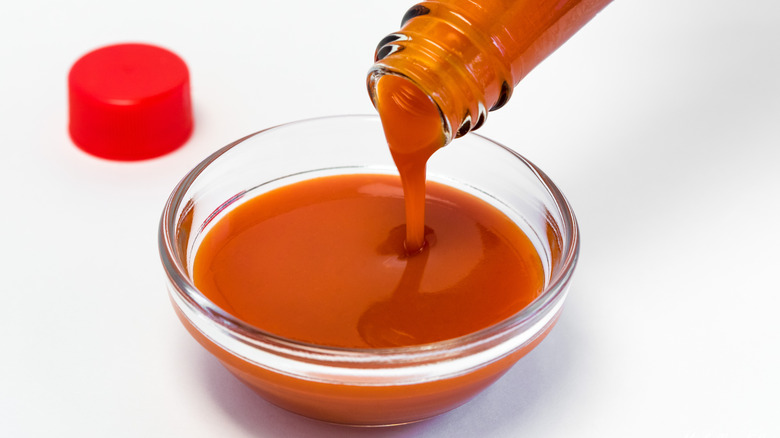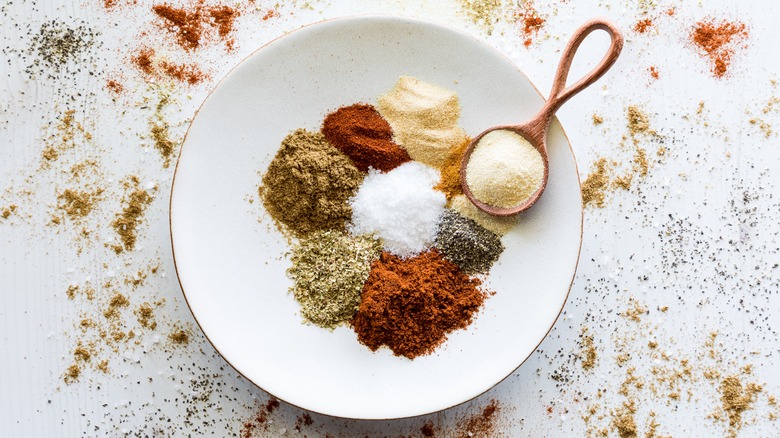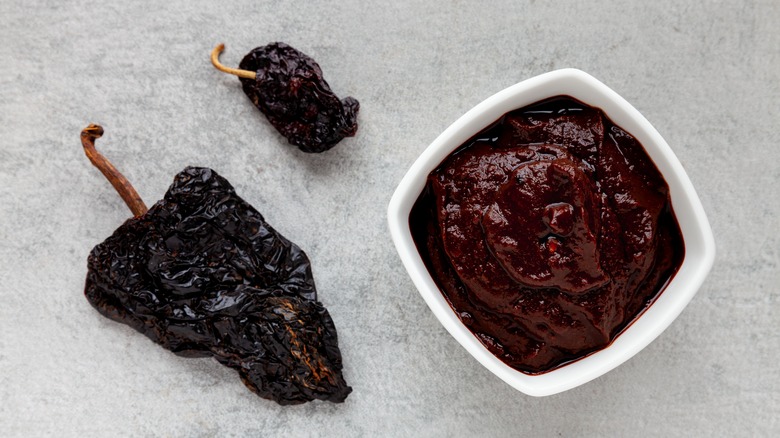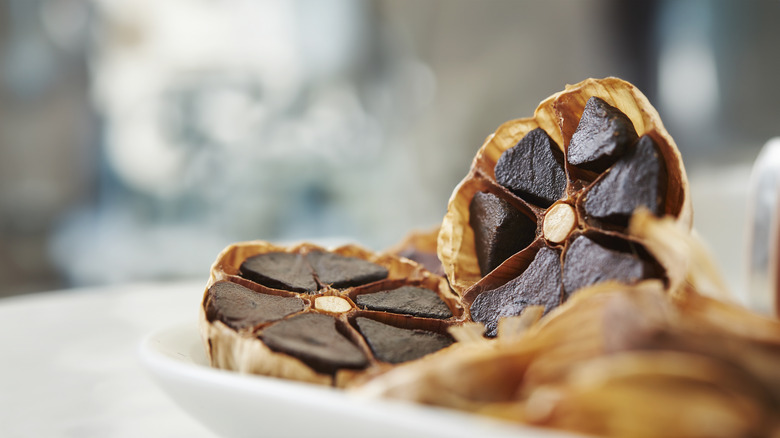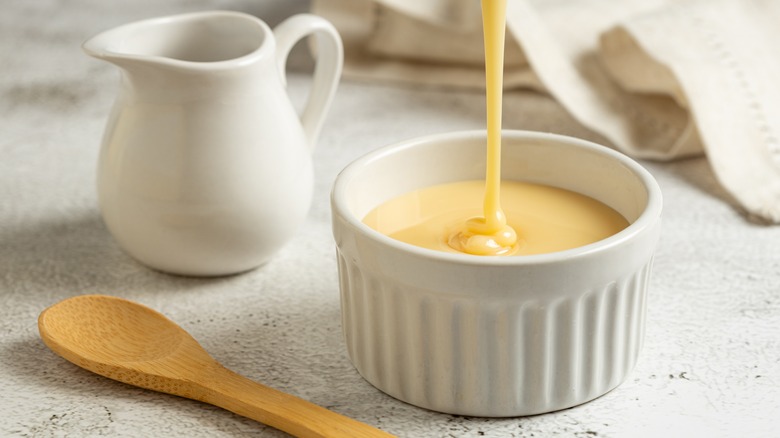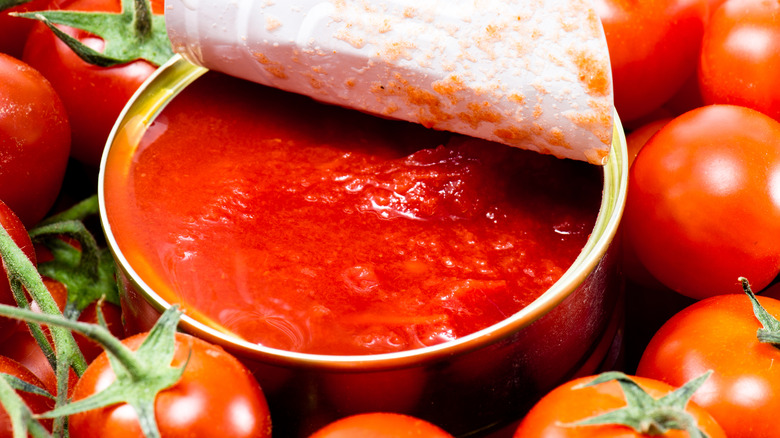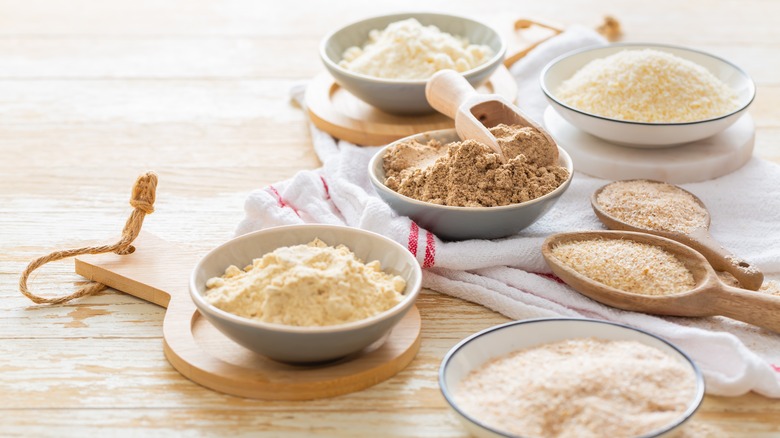Store-Bought Foods Chefs Secretly Love
Everything is better from scratch. At least, that's what many of us have learned through countless hours of watching cooking shows. Whether you're hankering after some red velvet cake or simply need a stick of butter to complement your freshly-baked sourdough, the going theory is that homemade is better than store-bought. Think of famed chef Alice Waters using a mortar and pestle to make aioli, or Julia Child's refrain that she didn't believe in bottled salad dressing.
Despite the many prominent examples of chefs making things from scratch, there are plenty of culinary luminaries who swear by having certain store-bought ingredients in their kitchens at all times. Some are logical (who has time to churn their own butter in a busy restaurant kitchen?), while others are more surprising (who knew store-bought breadcrumbs could be just as flavorful as homemade ones?). To discover some of the ingredients you should be adding to your shopping list, we spoke with several prominent chefs to discover which store-bought ingredients you'd find on their shelves and why.
Canned pumpkin
Pumpkin purée often consists of just one ingredient, but it's still difficult to make from scratch. With their solid texture and brittle skin, pumpkins require patience and muscle to peel and slice, let alone remove their pulp, cook, and blend or mash into a smooth consistency. All this can take an hour or more, which is a tall order when the purée is just one out of many ingredients for a complicated recipe.
Olivia Roszkowski, chef-instructor of Plant-Based Culinary Arts at the Institute of Culinary Education, told Mashed that she likes to buy canned pumpkin to use in pies, chilis, cinnamon rolls, and breads. She even uses it as an addition to oatmeal, saying it's "convenient and consistent in flavor and moisture level [and] saves a great deal of time that would alternatively be spent peeling, cutting, cooking and processing a squash or pumpkin." You might even find that canned pumpkin is more readily available than whole pumpkins at some supermarkets.
Tortillas
Homemade tortillas are unrivaled for their flavor and texture, but they require skill, experience, and a tortilla press to get right. Olivia Roszkowski explained that, while making your own tortillas can be a fun activity, it is also laborious, especially if you need to make a large quantity. Purchasing them is a good alternative because "there are a wide array of store-bought varieties that are economical, tasty, minimally processed and are usually a bit sturdier than homemade tortillas."
Iliana de la Vega, owner and head chef at El Naranjo Restaurant and winner of the 2022 James Beard Award for best chef in Texas, said that, while she always makes her own tortillas, she recommends that home cooks purchase high quality premade tortillas instead. "There are a few really good brands on the market," she said, "[S]o be sure the tortillas are from nixtamalized corn — and preferably no additives." Nixtamalization is a practice that goes back thousands of years and involves cooking and soaking dried corn kernels in an alkaline solution to make them more digestible and nutrient-rich. It also makes the texture of tortillas less crumbly and adds a nutty flavor. At El Naranjo, Chef de la Vega nixtamalizes heirloom Mexican corn in-house to form the restaurant's signature tortilla recipe.
Breadcrumbs
If you have stale bread and an oven or toaster, making breadcrumbs is easy. All you have to do is toast the bread, then roughly chop or blitz it in a food processor. Sometimes, however, you might not have stale bread to use, or you have nothing but that artisan loaf of sourdough that you paid through the nose for and aren't keen to lose. For this reason, Olivia Roszkowski recommends keeping some store-bought breadcrumbs in your pantry just in case. They're available at most grocery stores, affordable, and hassle-free so you don't have to add extra cooking time for your broiled crab cakes or crispy chicken nuggets.
Keep in mind that there is a difference between panko and other breadcrumbs. Panko breadcrumbs are unseasoned and made with crustless white bread, while anything labeled as merely breadcrumbs can be made with a variety of bread as well as seasonings. Panko breadcrumbs provide a lighter, drier texture and soak up less frying oil than other types of breadcrumbs.
Dried fruit, vegetables, and herbs
One of the best ways to extend the shelf life of fruits, vegetables, and herbs is to dehydrate them. But there is something unappealing about the idea of using dried produce instead of fresh. If you could choose between slices of fresh, juicy mango and dried ones, you'd probably pick the fresh option. Similarly, if your recipe calls for mushrooms, you'd probably rather buy fresh ones than rehydrate dried ones. It just seems logical that fresh fruits and veggies would be much more flavorful than ones that have been dehydrated and sitting on a shelf.
Despite what you might assume, however, there is good reason to favor dried goods over fresh. As Olivia Roszkowski explained, "Dried shiitake mushrooms, sun-dried tomatoes, dried mango, dried chilis as well as dried herbs (such as rosemary, thyme and dill) are usually harvested at peak season and dried with powerful machinery so the process is quicker and the plants generally retain more aromatic volatile compounds. They are also not so prone to absorbing residual moisture from the home environment, as they are [packaged] promptly and in such a manner as to retain freshness."
Nut or seed butters like tahini
Making nut or seed butter doesn't seem too difficult at first glance. All you need is a good blender, some salt, and nuts or seeds. But as Olivia Roszkowski pointed out, homemade nut butter is rarely as tasty or shelf-stable as store-bought butter. "It is a wise decision to purchase nut butters unless you plan on roasting the nuts or seeds, processing them[,] and storing them refrigerated for a short period of time," she said. "The reasoning is that the nuts and seeds can easily oxidize and become rancid. In manufacturing factories, the machinery is much more powerful and applies more pressure, allowing the nuts and seeds to be finely ground without producing so much residual heat."
If you have an overabundance of nuts or seeds and plan to eat the resulting butter quickly, there is no harm in making it at home. However, the flavor of store-bought nut and seed butters is at least comparable to homemade and even more delicious in some cases.
Coconut milk and coconut cream
Have you ever looked at a coconut and wondered how to make coconut milk out of it? Crack open a coconut and all you have is hard white meat and a viscous, clear liquid in the center. The "milk" product that you purchase at the store in jars, cans, or cartons is made by mashing grated coconut meat with water. It can be done at home, but as anyone who's tried to crack open a coconut can tell you, it's hard to even get to the meat let alone remove it from its shell.
"It is possible to make your own coconut milk at home from either fresh coconut or dried coconut flakes," Olivia Roszkowski conceded, but explained that the result "can be much more watery, has the tendency to separate more easily[,] and can also oxidize while being processed in a high power blender. The process also can require straining, which can be messy." Buying canned coconut milk and coconut cream will save you time and frustration, and ensure that the consistency is just right.
Jam
There are many reasons why you should consider making homemade jam. For one thing, it's a great way to use up fresh fruit before it starts to spoil, and it's especially worthwhile when you have a batch of freshly harvested berries that lack sweetness. Instead of wasting them, turning them into a delicious sweet and tart jam with the help of some sugar is well worth your time. However, when you don't have a bumper crop of blackberries or peaches on your hands, buying jam is preferable to spending hours making it with flavorless or pricy fruit.
As Olivia Roszkowski explained, store-bought jam is readily available, economical, and quick. "It can be hard to discern the difference between homemade and store-bought," she continued, "[S]o your time may be better spent elsewhere." The only time she doesn't recommend buying jam is if you really derive joy and satisfaction from making your own and have the time to do so.
Applesauce
Applesauce isn't just a snack found in the lunchboxes of elementary school children. It is also a transformative ingredient in a wide range of sweet and savory recipes. For example, our spiced zucchini bread recipe includes the delicious ingredient for added sweetness, moisture, and flavor, while our recipes for traditional latkes and potato pancakes suggest it as a sauce to provide a sweet and tangy flavor to the savory starch.
Given how useful applesauce is, it's worth having some around at all times, and as Olivia Roszkowski explained, it's probably better to buy it than make it from scratch. "Making apple sauce at home can be a fun craft when they are abundant and in season," she said, "[B]ut apple sauce is also economical and readily available for purchase. When using in baking, it can be hard to discern the difference and it is actually helpful to use a purchased product that has an industry standard for thickness and water content."
Oat and nut milks
Non-dairy milks are all the rage, with many stores devoting entire sections to them. These days, you can find oat milk, macadamia milk, coconut milk, soy milk, and even potato milk. Some of these options can be pretty pricey, especially for ones like oat milk and potato milk which are made with cheap ingredients. But making them at home will not produce the kind of results that many recipes are calling for, which is why chefs like Olivia Roszkowski prefer to purchase them instead of making them at home.
"Nut and oat milk companies often use stabilizers to prevent curdling, separation[,] and to extend shelf life," Roszkowski explained. The additives are what give these products a smooth, thick texture instead of a watery one, and if you're adding it to a recipe with the expectation that it will provide a velvety texture, homemade versions will likely yield disappointing results. Additionally, as Roszkowski explained, homemade nut milk does not have a long shelf-life. "If making your own batch at home," she said, "[I]t is advisable to use the mixture within two to three days or run the risk of curdling and rancidity."
Salsa huichol
Homemade salsa really can't be beat (just take a look at these amazing salsa recipes if you're not convinced). As long as you have the right ingredients, it is pretty straightforward to make. However, there is one type of salsa that Chef Iliana de la Vega chooses to purchase: salsa huichol. As she explained, salsa huichol is made in Mexico from a regional chile called chile Cora that she has found impossible to purchase in the U.S. As a result, buying the salsa is mandatory if you want its specific flavor.
Luckily, salsa huichol is available at many grocery stores. If you're looking for the best way to use it, Chef de la Vega told Mashed that it shines when paired with ceviche. It may not be a mandatory pantry item if you aren't regularly making ceviche or Mexican-inspired cuisine, but as Chef de la Vega noted, the unique flavor of chile Cora cannot be substituted, even with meticulously crafted homemade salsa using a different type of chile.
Spice blends
Many chefs like to make their own spice mixes. For example, as Sameer Kuthe, Chef de Cuisine at Baar Baar in New York told Mashed, every region in India, even every house, has its own unique blend of spices that they use in curries. There is no generic "curry powder" that fits every recipe because each cook has their own preferences and experience. Having a robust spice cabinet as a cook is like a painter having every variety of paint brush and every color of paint. It allows you to express your creativity, individuality, and preferences. Even home bakers who enjoy making the occasional cake or batch of cookies might prefer to deviate from their recipes and dial up certain spices and cut back on others.
But as Olivia Roszkowski explained, it isn't always necessary to have every option at your fingertips. "Spice blends such as shawarma, curry blends, and taco seasoning are great if you do not cook often, do not want to buy an excessive number of spices[,] or do not have the storage space," she said. "They will also be fresher when purchased in small quantities than trying to use up spices in your pantry over an extended period of time."
Chilis in adobo sauce
Chipotle chilis in adobo sauce are a staple of Mexican cuisine. Made by drying and smoking jalapeños and drenching them in a sauce made with tomatoes and spices, the ingredient is used in a wide variety of dishes, adding a powerfully smoky, spicy flavor. In fact, a can of chipotles in adobo sauce can single-handedly transform a recipe, whether you're making chicken tinga or spicy grilled meatloaf.
You could theoretically make your own version of this foundational ingredient, but it would take time to dry, smoke, and soak the peppers. Then there's the fact that the spiced tomato adobo sauce is not easily replicated. For this reason, Chef Iliana de la Vega says that she prefers to purchase them. Most options that you find at the store are full of flavor, easy to use, affordable, and, crucially, consistent in heat and taste, making it easy to add them to a recipe and know what to expect.
Chopped black garlic
Some of the ingredients that chefs love are not household staples. Take, for example, chopped black garlic. Made by curing fresh garlic in a warm environment (around 160 degrees Fahrenheit) for several weeks, it is, as its name suggests, black in appearance with a unique flavor. As it cures, the garlic undergoes the Maillard reaction, the process through which everything from toast to seared meat achieves its crispy brown exterior and nutty flavor. With careful humidity control, it also attains a sticky texture, while the flavor mellows from the pungent spiciness of raw garlic to something sweeter.
You can make black garlic at home, but it will take time and careful attention to temperature to get the expected results. Fortunately, you don't have to, and even chefs in some of the world's finest kitchens prefer to buy it readymade. Josh Feathers, Executive Chef of the Main House at Blackberry Farm in Tennessee, said that he likes to have a jar of chopped black garlic on hand to spoon onto just about any savory dish, explaining that it instantly elevates them.
Condensed milk
One ingredient that you might not think twice about buying is condensed milk, the thick, sweet canned milk that can be turned into dulce de leche, added to tres leches cake, and even used as a secret ingredient for more flavorful carnitas (trust us on this one). Made by removing at least 50% of the water content of milk and adding sugar, condensed milk can be made at home with just two ingredients, but few of us consider doing it let alone doing so regularly.
Iliana de la Vega doesn't worry about making it from scratch either. "When it comes to ready-made ingredients," she said, "[A] huge time saver is condensed milk. Not only do I love that it is ready to use, it's also a great product usually made with few ingredients — just milk and sugar, no additives. I like to make flan with it or dulce de leche."
Canned tomatoes
Nothing beats the acidic, sugary flavor of fresh tomatoes. When freshly harvested in the summer, these juicy vine-ripened fruits are good enough to eat like apples, and if you're lucky enough to have more than you know what to do with, there are plenty of recipes for fresh tomatoes that will repurpose them in imaginative ways. Once you've exhausted these options, you can try your hand at canning them. Unfortunately, this is an involved process that takes time and finesse, so you shouldn't feel guilty about skipping this option and buying canned tomatoes instead.
Olivia Roszkowski cited them as one of the ingredients she prefers to buy. "Unless skilled in properly canning tomatoes and performing the task in peak season," she said, "[P]urchasing canned tomatoes that have been harvested and processed peak season is a solid option." As with all ingredients, not all products are created equal, so we've created a list of 14 canned tomato brands, ranked worst to best, to help you pick the option that will yield the best results.
Gluten-free flour blends
If you follow a gluten-free diet or do a lot of gluten-free baking, you'll be familiar with the constant hemming and hawing over which type of flour to use. There's an embarrassment of riches these days, but few of them work perfectly on their own. From tapioca to rice to almond, it seems like pretty much every starch and nut has its own flour product for gluten-free enthusiasts to try. Unfortunately, the cost of these options adds up quickly, and if you're trying to find the perfect mixture, it can be hard to keep track of ratios.
For Olivia Roszkowski, the solution is to stick to a gluten-free flour blend. "If only baking occasionally, it is likely more economical to purchase a blend," she said. "These particular flours have the tendency to go rancid, so having an array in your pantry for extended periods of time is not recommended."
